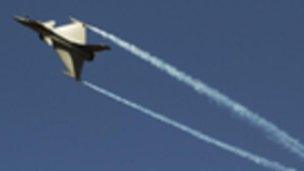India's insipid budget sticks to old script
- Published

This was the 7th budget for Finance Minister Pranab Mukherjee
Confidence about the economy's performance in the near future, good intentions, higher taxation and lack of concrete steps summarise India's 2012-23 budget.
Finance Minister Pranab Mukherjee's insipid budget struck to an age-old script to tax conspicuous consumption, force existing tax payers to pay more, dole out more largesse to impoverished sections of the population, bail out ailing sectors and talk about a few reform measures.
He tried to balance the contradictory, often conflicting, objectives to achieve higher growth to boost revenues, curtail government expenses to tackle fiscal imbalances, hike outlays for the welfare schemes meant for the poor and provide an economic road map.
To achieve growth of 7.6% in 2012-13, compared to the expected 6.9% this financial year just about to end, Mukherjee gave sops to critical sectors such as infrastructure, power, aviation and low-cost housing.
In order to boost revenues, he expanded the tax base and hiked existing rates and set a target to raise 300bn rupees ($5.8bn; £3.7bn) through disinvestment in state-owned companies; even as he provided minor incentives to individual tax payers and small retail investors.
Spending on conspicuous consumption, such as cars, gold and jewelry, and tobacco products, will also be more heavily taxed.
Mr Mukherjee estimated that all these measures would increase revenue by more than 400bn rupees next year.
Defence spending spree
The focus to reduce expenditure fell on the growing subsidies for food, fertilizers and fuel.
Post-budget, in an interview to an Indian news channel, Prime Minister Manmohan Singh said the government was willing to "bite the bullet" to reduce subsidies from 2.5% of Gross Domestic Product (GDP) today to 2% next year and further to 1.7% within three years.
Mr Mukherjee said pilot projects would be initiated this year to ensure subsidies are delivered to their intended targets efficiently and without being diverted by corruption.

India has gone on a military spending spree to modernise its armed forces
As part of this, India's ongoing project to include the entire population in a biometric identity database would be fully rolled out by December 2012, he said.
Despite such moves, the fiscal deficit is expected to rise to 5.9% of GDP in 2011-12, from the projected 4.6%; however, it would be reduced to 5.1% in 2012-13, the finance minister projected.
Given the government's consistent emphasis on "inclusive" growth, the expenditure on welfare schemes has gone up, and new schemes have been announced in this budget.
Additional incentives come in the form of lower interest rates for farmers, more credit to be allocated to farmers and a promise to implement the food security bill.
Additional money was announced for defence too, with spending to jump by 17% to 1.93tn rupees in the coming year.
Mr Mukherjee said that while more than 40% of it would be spent on capital investment, there would be no dearth of funds if the armed forces required more money.
India has been on a buying spree for defence equipment recently.
It signed a deal worth up to 1tn rupees with France's Dassault Rafale to procure 18 medium multi-role combat aircraft in flyaway condition with the option to build another 108 under licence by state-owned Hindustan Aeronautics Ltd.
Mr Mukherjee paid lip service to criticisms that the government is unable to push through economic reforms because of politcial pressure from its coalition allies.
He announced that several pending economic bills would be introduced in parliament, the direct tax code and a goods and services tax (GST) would be finalised soon and foreign direct investment might be allowed in retail and aviation.
It was a budget that tried to please everyone and was determined to balance the expenditure, revenue and deficit numbers.
It reminded many of the budgets of the 1980s; it did not seem like one for the 21st Century.
Alam Srinivas is a business analyst who has covered the government budget for more than two decades.
- Published14 March 2012
- Published15 March 2012
- Published15 March 2012